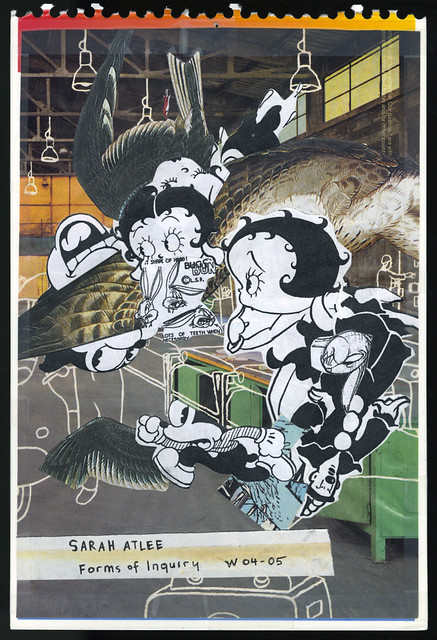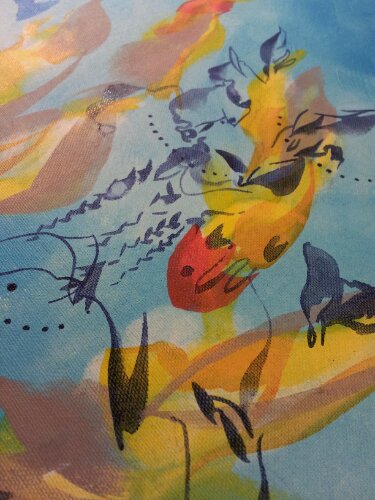The Creative Genie
Elizabeth Gilbert, author of Eat Pray Love, talks about the mysteries and frustrations of the creative process. Below the video is a sampling of free associations from when I watched the video myself.
03:50 "Somehow we've completely internalized and accepted, collectively, this notion that creativity and suffering are somehow inherently linked. And that artistry, in the end, will always ultimately lead to anguish. ...I'm not at all comfortable with that assumption. I think it's odious, and I also think it's dangerous. And I also don't want to see it perpetuated into the next century."
Fortunately, in this 'next' century, we are seeing an increasing awareness and encouragement of the creative class, and of makers in general.
I remember my Dad, the artist. He was creative in many areas of his life - gardening, cooking, pottery, weaving, calligraphy, teaching, raising a daughter. He tried many things, and never restricted himself to a single medium.
Origins of the words "Genie" and "Genius"
Genie "mid 17th century (denoting a guardian or protective spirit): from French génie, from Latin genius (see genius). Génie was adopted in the current sense by the 18th-century French translators of The Arabian Nights' Entertainments, because of its resemblance in form and sense to Arabic jinni 'jinnee'"
Genius "late Middle English: from Latin, 'attendant spirit present from one's birth, innate ability or inclination', from the root of gignere 'beget'. The original sense 'spirit attendant on a person' gave rise to a sense 'a person's characteristic disposition' (late 16th century), which led to a sense 'a person's natural ability', and finally 'exceptional natural ability' (mid 17th century)"
09:25 "There's probably people in this audience who would raise very legitimate scientific suspicious about the notion of, basically, fairies who follow people around, like, rubbing fairy juice on their projects... Why not think about it this way? Because it makes as much sense as anything else I have ever heard in terms of explaining the utter, maddening capriciousness of the creative process."
That Thing
11:57 "I'm not the pipeline. I'm a mule. And the way that I have to work is that I have to get up at the same time every day and sweat, and labor, and barrel through it really awkwardly. But even I, in my mulishness, have brushed up against that thing."
That thing, I've felt it. A quickening of the pulse, a brush with a tangent universe in which my painting is finished and brilliantly realized. I can suddenly see where I need to go.
Because That's My Job
But it doesn't come all at once, except perhaps once every great while. I have to get up at the same time every day and go into the studio and work. I work to be workful. I pursue relaxed concentration.
How lucky the students of University of Wisconsin - Madison are to have the chance to take Lynda Barry's next class! The Unthinkable Mind will be "A writing and picture-making class with focus on the basic physical structure of the brain with emphasis on hemispheric differences and a particular sort of insight and creative concentration that seems to come about when we are using our hands (the original digital devices) to help us figure out a problem." Sadly, I am not a student at UW, but I hope that Ms. Barry will share her students' work on The Nearsighted Monkey like she did for the What It Is class.
14:58 "So I just lifted my face up from the manuscript and I directed my comments to an empty corner of the room, and I said aloud, 'Listen, you, thing. You and I both know that if this book isn't brilliant, that is not entirely my fault, right? Because you can see that I am putting everything I have into this. I don't have any more than this. So if you want it to be better, then you gotta show up and do your part of the deal, okay? But if you don't do that, you know what? The hell with it. I'm going to keep writing anyway because that's my job."
What does my genie look like?
I thought of Technical Boy from American Gods by Neil Gaiman. Also, Tavi Gevinson.
And, coincidentally, The Oatmeal's take on being a content creator (whole comic very much NSFW):
"Art is not born in a vacuum, but it's not born inside a tornado full of shrieking trolls, either."
Opportunities and Competition
 Colourful Army by Flickr user Maistora. Click image to view source.
Colourful Army by Flickr user Maistora. Click image to view source.
This summer has seen a handful of terrific opportunities for visual artists in Oklahoma. Among others, I have just applied for a brand new artist residency at the landmark Skirvin Hotel in downtown OKC.
S.P.A.C.E. - The Skirvin Paseo Artist Creativity Exposition
This is a beautiful program, the first of its kind in our area. The Paseo Arts Association has modeled it off of a similar residency at the Pfister Hotel in Milwaukee, Wisconsin. It includes studio and gallery space, a stipend, even free lunches - for a year.
The application was not widely publicized. But when I heard about it, I told my friends, I posted it on Facebook, and otherwise helped spread the word. I wanted everyone I knew to apply along with me.
Why create more competition for myself?
The fact that OKC now has an artist-in-residence program of this kind is remarkable. It elevates our entire community. I couldn't possibly keep this to myself, because it's good for all of us.
Competition fosters quality.
I know several of the other applicants, and they are great artists! I had to step up my game to compete with them. If every applicant makes their proposal as strong as possible in order to be competetive, then the winning artist is going to be a truly shining example of visual arts in Oklahoma. They are going to make us all look good by creating excellent art in a public, professional space.
I wish we could all win. Because we'd all be awesome.
But what if I don't win?
My colleague Liz Roth often says that she gets about a 10% rate of return when applying for grants and residencies, meaning that about one in ten of her applications is accepted. That's why she encourages artists to pursue many different opportunities.
I put a lot of energy into my proposal, to make sure it looks professional, is easy to read, and communicates my ideas effectively. If my proposal for S.P.A.C.E. isn't accepted, I still have a great idea to shop to galleries, or use to apply for grants or other residencies. (Need I say that I'll make sure to adapt it as per other submission requirements? It almost, but not quite, goes without saying.)
And hey, there's always next year!
I will be speaking at two Artist Survival Kit workshops this fall about writing effective proposals. Visit the Oklahoma Visual Arts Coalition's A.S.K. page for more information on dates and registration.
Bonus: There is a slew of good advice about proposal writing at the OVAC blog.
Forms of Inquiry Notebook Cover Collage, 2004
 This is the cover from a notebook I used in a graduate seminar at the Rochester Institute of Technology.
This is the cover from a notebook I used in a graduate seminar at the Rochester Institute of Technology.
Can a notebook cover be a work of art? Heck, why not? Decorating mundane objects from daily life differentiates them from one another, plus it's something to do.
I'm no Lisa Frank, but seeing this collage does bring back fond memories of my time at RIT.



